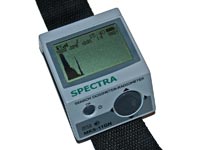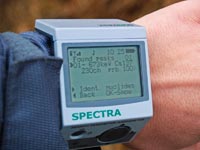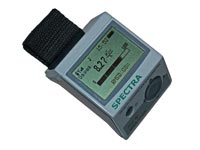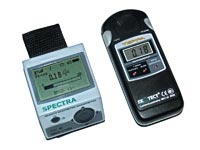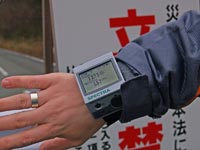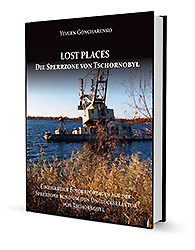Technical characteristics. Usage impressions.
With the search dosimeter-radiometer MKS 11 “Spectra” I get acquainted just a few days before the trip to Japan (to Fukushima prefecture, affected by the accident at the Fukushima-Daiichi Nuclear Power Plant) at the end of December 2011. SPPE “Sparing-Vist” gave me a pre-production engineering sample for field testing. After a short briefing I was given a cardboard box with the device, pair sets of batteries and charger for them, operating manual, CD with software “Spectralog” and a screwdriver. Before that I had no experience with the equipment of such type and level: the search scintillator and with the function of identification of radionuclides at that, so I was interested to work with the device in real-time use of radioactive contaminated area.
Search dosimeter-radiometer MKS-11 GN “Spectra”
According to tradition I should begin with the description of the package, but since I got a pre-production sample, it was packed into the first box that comes across. Production versions will be sold in plastic cases.
I already wrote above about delivery set, also I can only mention a leather carrying case for the detection device.
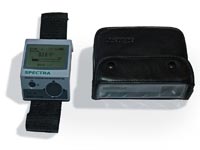 |
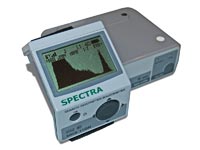 |
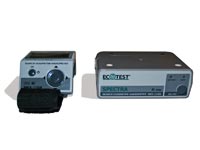 |
Structurally, the search dosimeter-radiometer MKS-11 GN “Spectra” consists of two parts: the detecting device (on photos it is located on the right), hereinafter referred to as “DD” and the control and indication wrist device, hereinafter referred to as “CID”. Data communication between devices is provided via Bluetooth.
DD is made in plastic body (the same used in a search alarm dosimeter DKS-02PN “CADMIUM”). The front panel has only one control element – on/off button of DD and two LED lights: Bluetooth connection indicator and DD charge indicator.
CID is made in aluminium body. It has two control elements: CID power button “On” (also used as an input button “Ok” in some modes of operation of the device) and a large four-way control button. The entire top panel is a monochrome graphical display with luminescent backlight.
Both devices have IP54 ingress protection rating.
The letters “GN” in the devise’s name mean the ability to measure gamma and neutron radiation. This is a top modification of “Spectra”. “Sparing-Vist” is now preparing for release a simplified “G” version, which will be without the possibility of measuring the neutron flux. Besides that “G” version will have a different design concept – a monoblock.
Purpose of use
- Search dosimeter-radiometer MKS-11 “Spectra” is designed to measure ambient dose equivalent rate of gamma and X-ray radiation (hereinafter called photon-ionizing radiation DER), to determine neutron radiation intensity, as well as to identify gamma radionuclides. The device provides accumulation, saving in the non-volatile memory and identification of amplitude gamma spectra.
Features
- High sensitivity gamma scintillation (CsJ) detector, Geiger-Muller counter (DER turns on at levels exceeding 10 μSv/h), scintillation (LiJ) detector of neutron radiation.
- Mode of indication and automatic testing of batteries residual capacity.
- Data communication between the detecting device (DD), the control and indication device (CID) and the PC is done via Bluetooth wireless technology.
- Option to save and transfer to personal computer 128 full gamma radiation spectra.
- Identification of radionuclides with indication of the category that they belong to (in compliance with IAEA requirements):
- medical radionuclides: 18F, 67Ga, 99mTc, 111In, 123I, 131I, 201Tl;
- industrial radionuclides: 57Co, 60Co, 133Ba, 134Cs, 137Cs, 192Ir, 152Eu, 241Am;
- special nuclear materials: 233U, 235U, Pu [reactor-grade plutonium (more than 6% 240Pu)];
- naturally occurring radioactive materials: 40K, 226Ra, 232Th and daughters, 238U and daughters.
Note: The list of nuclides that can be detected by the device can be enlarged if needed.
- Threshold alarm system with three independent threshold levels:
- search threshold level (threshold level of pulse count rate from the detector of photon-ionizing radiation);
- safety threshold level (threshold level of photon-ionizing radiation DER);
- threshold level of pulse count rate from the detector of neutron radiation.
The main technical characteristics
|
||
|
(pulse/s)/(µSv/h)
|
100±15
|
|
pulse*centimeter² / neutron
|
0,120±0,012
1,2±0,12 |
|
µSv/h
|
0,05 - 9999
|
|
pulse/s
|
1 - 9999
|
|
pulse/s
|
0,01 - 9999,00
|
|
%
|
±(15+1/H*(10)), where H*(10) - is a measured value of DER, equivalent to µSv/h
|
|
MeV
|
0,033 - 3,000
|
|
%
|
±25
|
|
MeV
|
from thermal neutrons to 14.00
|
|
channel
|
1024
|
|
min
|
1
|
|
c
|
2 - 60
|
|
h
|
30
|
|
°С
|
- 20 ... + 50
|
|
mm
|
110x36x83
|
|
kg
|
0,4
|
|
mm
|
70x80x32
|
|
kg
|
0,13
|
|
kg
|
1,5
|
The unit separation into two blocks determines the procedure of turn on/off. To activate the device, first press and hold the button “On” on side panel of CID. CID is switched on and goes into search mode to connect with DD. Press the button “On” on front face of DD. Within a few seconds both devices are interconnect and the device enters the automatic calibration of detectors. The entire procedure takes less than a minute and then the device is ready for use. The devise can be turn off (both devices at once) by selecting the appropriate menu item in the CID.
After switching and calibration “Spectra” goes into default mode of measurement of photon-ionizing radiation DER and neutron flux. The screen displays the level of gamma radiation in μSv/h and pseudo-analogue scale. You can also choose two more options to display: gamma in μSv/h + neutron flux in CPS and gamma and neutrons in CPS or move to the mode of accumulation of gamma radiation spectra and identification of radionuclides.
Besides this the screen constantly displays additionally: error of measurement (during DER measurements), the level of battery discharge of CID and DD, Bluetooth signal strength, current time and the indicator of switching on of audible signal.
At first, what I substantially liked
Work with the devise
Work with the device is very simple and handy. And this is despite of the large number of functions and modes. The presence of a graphic display and four-way control button made possible to organize a simple and intuitive menu (you can also select the menu language: English or Russian). Of all the devises with which I had to deal with – MKS-11 GN “Spectra” is the most functional and at the same time, the most simple and easy to use. I read the manual only once and then only to clarify some points.
The sensitivity and speed of reaction
Unfortunately I have not had the opportunity to compare the “Spectra” by these parameters with similar devices, but of course the device with a scintillation detector has a much greater sensitivity and speed of response on changes in the level of gamma radiation than any device with a GM detector.
Analysis of gamma-ray spectra, the identification of radionuclides and work with the software “Spectralog”
“Spectra” is simple, easy-to-use and efficient devise, even for users who do not possessing special knowledge in gamma-ray spectrometry.
What has raised questions
Power supply and non-volatile memory
The device is quite “voracious”, especially in long exposure mode of the accumulation of gamma-ray spectra; also the Bluetooth connection does not add economy. DD power – one AA battery, CID - two AAA batteries. I used the most, at the moment, capacious AA batteries – 2750 mAh, AAA – 1000 mAh. It was enough a maximum of one and a half to two days of work. So you should a reserve set of batteries and... a slot screw driver. This is the next point, which causes some discomfort. If the batteries are not changed so often, one could not pay attention on this.
To continue with what has been said about changing batteries there is some issue with non-volatile memory. Yes, it is available, and it stores all the settings and accumulated gamma spectra, but when you change batteries of CID, the current time and date reset. Also, there is a certain inconvenience in the memory organization of gamma-ray spectra. As I wrote above, the MKS-11 GN “Spectra” can store up to 128 results, but, so to speak, in one block. That is to say, if you have already recorded a result in the device's memory, you can erase it, but only along with all the archive of the 128 positions. Of course, this can be done easily on a PC, if you copy there the entire archive of measurements, but it is impossible to erase the exact record just on devise.
|
Software “Spectralog” — 60Co |
Software “Spectralog” — 137Cs |
Software “Spectralog” — “Fukushima spectrum” — 134Cs, 137Cs |
 |
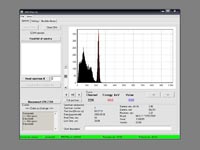 |
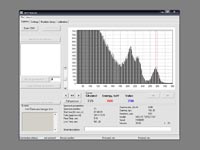 |


What I do not like: the relatively high power consumption and the inconvenience of batteries replacement. A small communication range via Bluetooth.
The summary.
I have not had the opportunity to compare the MKS-11 GN “Spectra” with similar devices, but in any case, I liked the device. It's quite easy to manage and easy to use devise. The separation of the device on two devices can cause issues: high power consumption, a Bluetooth connection between the separate units. But actually it is very comfortable to have a wrist indicator. I worked for two weeks with the device and I can definitely say – I liked such arranging. And if it is necessary to pay for this with the high power consumption and battery replacement discomfort – I'm ready to go at it.
At my personal 10-point scale, I give “Spectra” 9 points. A great devise.
Gratitude for providing the device goes to SPPE “Sparing-Vist Centre”.
Author: Yevgen “KRANZ” Goncharenko
| The “Gamma Sapiens” intellectual gamma radiation detector< Prev | Next >The Radiometer-dosimeter RKS-01 “Stora-TU”. The New Version |
|---|








